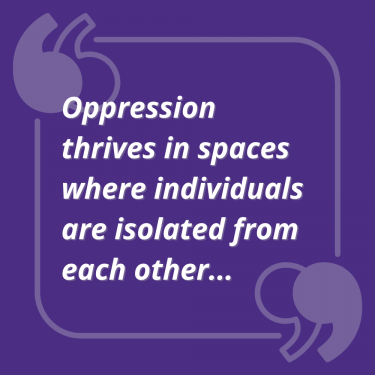January 24, 2022
Racial Caucusing: What is it, and how can it help?
1/12/2022 – Victoria Robinson
You may have heard the term “affinity group”, or even “resource group”, in your organization or classroom, especially if your organization is focused on improving their diversity, equity, and inclusion framework. But what does it mean, and how does an affinity group, or caucus, offer important opportunities to their members?
Though the origin of the word is debated by etymologists, the most popular opinion is that caucus is derived from the Algonquian word cau’-cau-as’u, or a group of leaders or advisers. The term has evolved to mean a meeting of individuals who share an identity or interest, an opportunity to discuss and confer, to express shared truths and experiences.
Racial caucusing is exactly that: a space for individuals linked by racial identities to share their knowledge and to come to common understandings about their experiences in a multiracial world. Caucuses based on racial identity allow time for people of color, white people, and people with mixed-race identities to gather and engage in conversations about their racialized identities and experiences, sometimes as a response to a crisis, sometimes as a proactively planned learning opportunity for self-awareness.
 “In contrast to explicit bias or unconscious similarity bias that can lead to homogenous spaces and networks, racial caucusing is done with explicit, racial justice goals in mind,” argues Omid Bagheri at JustLead Washington. “Under the call to build community in the name of anti-racism, caucus work benefits both people of color and white people. In addition to building relationships and support, participants can also build strategy and collective power if they commit to working together, becoming a ‘body politic that can be capable of generating more influence and energy for race equity change than individuals can generate and sustain on their own.”
“In contrast to explicit bias or unconscious similarity bias that can lead to homogenous spaces and networks, racial caucusing is done with explicit, racial justice goals in mind,” argues Omid Bagheri at JustLead Washington. “Under the call to build community in the name of anti-racism, caucus work benefits both people of color and white people. In addition to building relationships and support, participants can also build strategy and collective power if they commit to working together, becoming a ‘body politic that can be capable of generating more influence and energy for race equity change than individuals can generate and sustain on their own.”
Racial caucusing is about learning how to decenter whiteness and the tenets of white supremacy, using either a platform of BIPOC (Black, Indigenous, People of Color) empowerment or white solidarity to do so. For people of color, a racial caucus offers a brave space to talk about their experiences in a white-dominant society, creating an antidote to white-dominated spaces and instead building a “counterspace” in which BIPOC can speak freely without scrutiny. 
For white people, a racial caucus creates an arena within which white people are able to work through barriers that prevent them from allying together toward anti-racist goals, such as unexplored power and privilege, or unpacking internalized racism. The white caucus is a space to discuss emotions, questions, and “learning edges” without causing harm to people of color.
While the work of facilitating a caucus is more complex than “sit people down and have them talk”, the trend of racial caucusing in formal organizations is growing, offering regularized spaces for individuals to bring their life-experiences to the table, connecting with folks of a shared identity and building the base for anti-racism work in their company, campus, or community.
By including racial caucusing in the classroom, instructors foster an environment of belonging and support, helping students navigate the uneven ground of higher education1. It invites students to connect with each other on a more profound level and to develop the listening and communication skills needed for the important work of consciousness raising2. Oppression thrives in spaces where individuals are isolated from each other, unable to connect their individualized experiences to a larger systemic perspective; the caucus is a space to negate that isolation and provide students the chance explore the common threads that run through their independent stories.
For more information on equity and connection practices in the classroom, check out the Well-Being for Life and Learning Guidebook. If you are interested in learning about, organizing, and/or effectively facilitating a caucus/affinity group, JustLead Washington has a comprehensive toolkit for you at JustLeadWA.org/learn
Notes:
1 To learn more about the national dialogue on diversity and inclusion in higher education, visit the American Council of Education’s blog series “Higher Education Today: The National Dialogue on Diversity and Inclusion”
2 The term ‘consciousness raising’ has historically been used to describe the group process of understanding personal experience through the lens of sociopolitical power structures.
References:
American Council on Education. (2022). Higher Education Today: The National Dialogue on Diversity and Inclusion. https://www.higheredtoday.org/policy-research/campus-climate-inclusion/campus-climate-national-dialogue-diversity-inclusion/
Bagheri, O. (2019). Caucuses as a racial justice strategy: What we have learned. JustLead Washington. https://justleadwa.org/wp-content/uploads/2019/07/Caucuses-as-a-Racial-Justice-Strategy-JustLead-WA.pdf
Larson, P. (2014). Consciousness-Raising Groups. In Teo, T. (ed) Encyclopedia of Critical Psychology. Springer.
